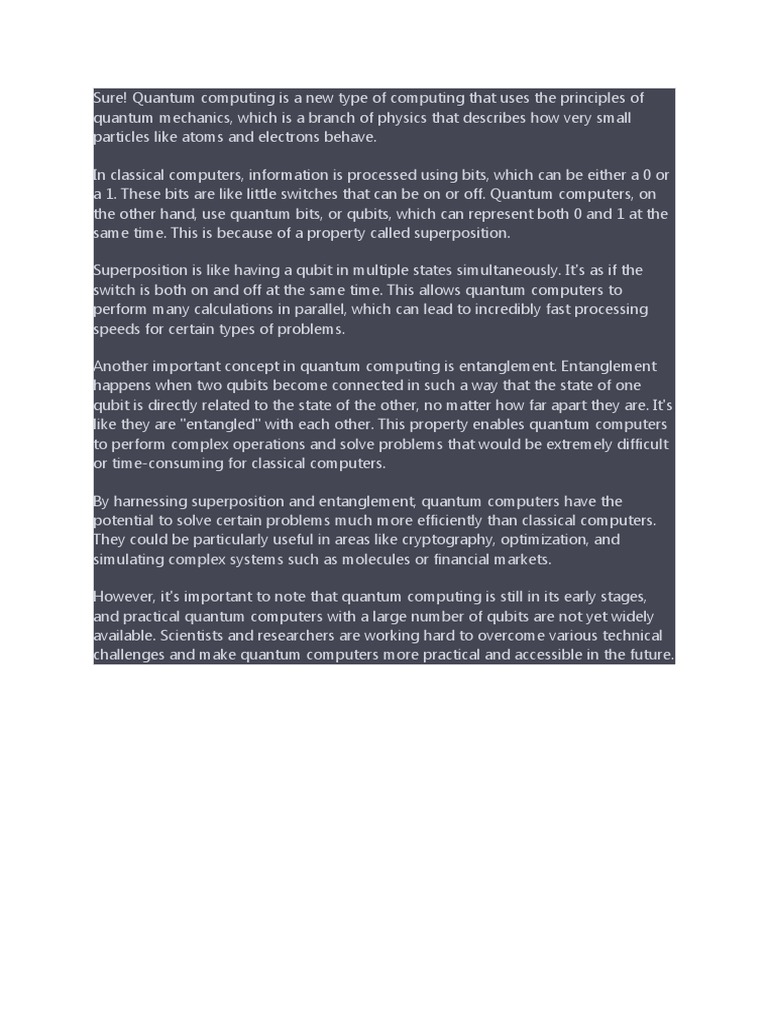In an age dominated by technological marvels, the advent of quantum computing emerges as a paradigm shift akin to the revelation of electricity to early 19th-century scientists. Quantum computing may seem abstract, even bewildering, to those uninitiated in physics, yet its implications are vast and transformative. To navigate this intricate landscape, consider the metaphor of a symphony orchestra: each component, from the mighty qubit to complex algorithms, plays a vital role in the harmonious execution of computational tasks.
At the heart of quantum computing lies the qubit, a term that invites curiosity and contemplation. Unlike classical bits, which can exist in a state of either 0 or 1, qubits materialize in a realm of superposition. This means that a qubit can simultaneously embody both states, akin to a musician playing multiple notes at once, creating layers of sound. The capacity to exist in a superposition allows quantum computers to process vast swathes of information concurrently, thus performing calculations at breathtaking speeds.
To further exemplify, envision the qubit as a coin spinning on a table. While it rotates, it occupies a state that is both heads and tails. Only when the coin comes to a stop—analogous to the measurement of a qubit—does it reveal a definite outcome. This peculiar characteristic of superposition is profound and underpins the exceptional computational efficiency of quantum machines.
Yet, the qubit’s capabilities don’t merely rest on superposition; entanglement introduces another layer of complexity, akin to a duet between two musicians whose instruments resonate in tandem. When qubits become entangled, the state of one qubit becomes indelibly linked to the state of another, regardless of the distance separating them. This remarkable phenomenon means that altering one qubit instantaneously influences its entangled partner. The implications of entanglement extend into realms such as quantum cryptography and secure communication, rendering information transmission exquisitely secure while paving the way for a more interconnected digital future.
But with great power comes great responsibility. The susceptibility of qubits to decoherence—a phenomenon that disrupts quantum states—poses significant challenges. Like a musician struggling to maintain a steady tempo amidst the chaos of an unexpected noise, qubits must remain coherent long enough to perform their brilliant calculations. Environmental factors such as temperature, electromagnetic radiation, and even cosmic rays can hasten the degradation of quantum states. Hence, quantum researchers endeavor to develop robust error correction methods and sophisticated algorithms designed to protect qubit integrity.
The potential applications of quantum computing span an impressive array of fields, painting a vivid tapestry of what the future may hold. In the realm of pharmaceuticals, quantum computers could expedite drug discovery by simulating molecular interactions with unparalleled precision. As molecules dance and collide in quantum simulations, researchers gain insights faster than ever, effectively revolutionizing the medical landscape.
Moreover, in the financial sector, quantum computing promises to elevate portfolio optimization and risk analysis, providing strategies that were previously unconceivable. Picture an orchestra adjusting its performance seamlessly in response to the evolving nuances of a live audience—a quantum computer can adapt its operations fluidly, recalibrating investment approaches dynamically based on real-time data contingencies.
Additionally, in the domain of artificial intelligence, quantum algorithms hold the potential to process information far beyond the capabilities of classical systems. Machine learning processes that rely on immense datasets can be accelerated significantly, bestowing AI algorithms with a heightened ability to discern patterns and yield predictive models. This capacity to bolster AI could herald a new era of technological symbiosis, where human ingenuity is augmented by quantum insights.
As we traverse the realm of quantum computing, one might ponder the existential questions it raises. Will society adapt to the unprecedented capabilities of these quantum computers? Will they alter the fundamental fabric of our day-to-day interactions with technology? The answers remain nebulous, but it is certain that just as individuals once grappled with the moral implications of harnessing electricity or splitting the atom, so too must contemporary society engage with the ethical dimensions posed by quantum advancements.
In conclusion, as we unravel the complexities of quantum computing, we embark on an exhilarating journey—a dissonance of notes that promises to resolve into a magnificent symphony of innovation. The qubit stands as the cornerstone of this transformative landscape, where superposition and entanglement grant unprecedented computational power. The challenges, akin to the nuances of a demanding symphonic score, require finesse and diligence. The applications stretch across disciplines, poised to redefine paradigms from healthcare to finance, and AI to communication. Through the lens of an orchestra, we witness the unfolding of a new era, a testament to human resilience and ingenuity as we conduct the quantum future.












